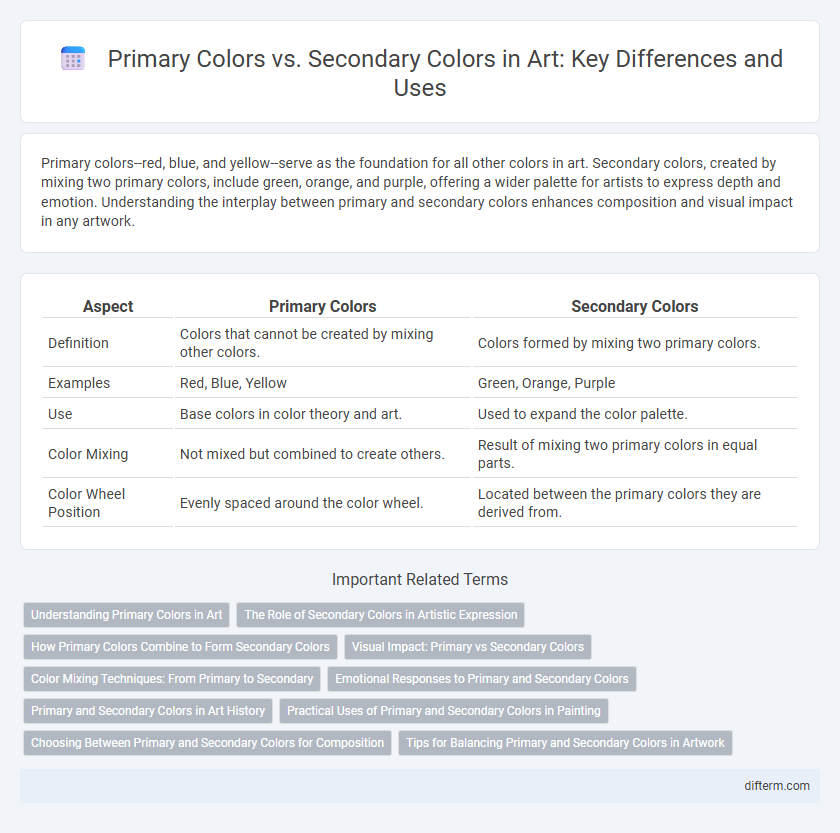Primary colors--red, blue, and yellow--serve as the foundation for all other colors in art. Secondary colors, created by mixing two primary colors, include green, orange, and purple, offering a wider palette for artists to express depth and emotion. Understanding the interplay between primary and secondary colors enhances composition and visual impact in any artwork.
Table of Comparison
| Aspect | Primary Colors | Secondary Colors |
|---|---|---|
| Definition | Colors that cannot be created by mixing other colors. | Colors formed by mixing two primary colors. |
| Examples | Red, Blue, Yellow | Green, Orange, Purple |
| Use | Base colors in color theory and art. | Used to expand the color palette. |
| Color Mixing | Not mixed but combined to create others. | Result of mixing two primary colors in equal parts. |
| Color Wheel Position | Evenly spaced around the color wheel. | Located between the primary colors they are derived from. |
Understanding Primary Colors in Art
Primary colors--red, blue, and yellow--serve as the foundation for all other hues in art, as they cannot be created by mixing other colors. These colors are essential for color theory, enabling artists to produce a full spectrum by combining them in various ways. Mastery of primary colors enhances an artist's ability to manipulate tones, contrasts, and color harmony within their work.
The Role of Secondary Colors in Artistic Expression
Secondary colors, created by mixing two primary colors, play a crucial role in artistic expression by expanding the palette available for nuanced compositions. These colors--green, orange, and purple--offer artists dynamic contrasts and harmonious blends that enhance depth and emotional impact. Utilizing secondary colors effectively allows for more complex visual storytelling and the evocation of varied moods within a piece.
How Primary Colors Combine to Form Secondary Colors
Primary colors--red, blue, and yellow--serve as the fundamental pigments in art, each representing a unique wavelength of light. When mixed in equal parts, these primary colors create secondary colors: red and blue produce purple, blue and yellow yield green, and yellow and red result in orange. Understanding this color theory principle enables artists to manipulate hue and saturation effectively, enhancing visual composition and emotional impact.
Visual Impact: Primary vs Secondary Colors
Primary colors--red, blue, and yellow--create the most striking visual impact due to their pure, unblended intensity, capturing immediate attention and evoking strong emotional responses. Secondary colors--green, orange, and purple--formed by mixing primary colors, provide a more nuanced, harmonious visual effect that balances and complements the boldness of primaries. Understanding the dynamic between primary and secondary colors enhances artistic compositions by manipulating contrast, mood, and focal points effectively.
Color Mixing Techniques: From Primary to Secondary
Primary colors--red, blue, and yellow--serve as the foundation for all color mixing techniques in art. By combining equal parts of two primary colors, secondary colors like green, orange, and purple emerge, creating a dynamic palette for artists. Mastery of these mixing methods enhances color harmony and depth in artistic compositions.
Emotional Responses to Primary and Secondary Colors
Primary colors like red, blue, and yellow evoke strong and direct emotional responses such as excitement, calmness, and happiness due to their pure wavelength qualities. Secondary colors, formed by mixing primary colors, often generate more complex and nuanced feelings, like creativity from green, warmth from orange, and tranquility from purple. Understanding these emotional impacts helps artists strategically use color to influence mood and viewer perception in their work.
Primary and Secondary Colors in Art History
Primary colors--red, blue, and yellow--serve as the foundational hues in art history, enabling the creation of secondary colors through their combinations. Secondary colors, formed by mixing two primary colors, include green, orange, and purple, each holding distinct symbolic and cultural significance across artistic movements. This color theory framework has profoundly influenced painterly techniques, color symbolism, and the evolution of visual expression throughout art history.
Practical Uses of Primary and Secondary Colors in Painting
Primary colors--red, blue, and yellow--serve as the foundation for all color mixing in painting, enabling artists to create a vast spectrum of hues by blending them. Secondary colors--green, orange, and purple--are formed by mixing two primary colors and provide painters with richer, more complex tones essential for depth and contrast. Utilizing primary colors allows for crisp, vibrant compositions, while secondary colors enhance shading and harmony, making both crucial for balanced and dynamic artworks.
Choosing Between Primary and Secondary Colors for Composition
Choosing between primary and secondary colors for composition significantly influences visual impact and harmony in artwork. Primary colors--red, blue, and yellow--offer bold, vibrant contrasts that create a strong focal point and dynamic energy. Secondary colors--green, orange, and purple--derived from mixing primaries, provide balanced, nuanced tones that promote cohesion and depth in the overall composition.
Tips for Balancing Primary and Secondary Colors in Artwork
Balancing primary colors--red, blue, and yellow--with secondary colors--green, orange, and purple--enhances harmony and visual interest in artwork. Use primary colors selectively to create focal points and secondary colors to provide depth and contrast, maintaining color saturation to avoid overpowering the composition. Incorporating complementary color pairs from both groups helps achieve dynamic balance and guide the viewer's eye effectively.
primary colors vs secondary colors Infographic

 difterm.com
difterm.com